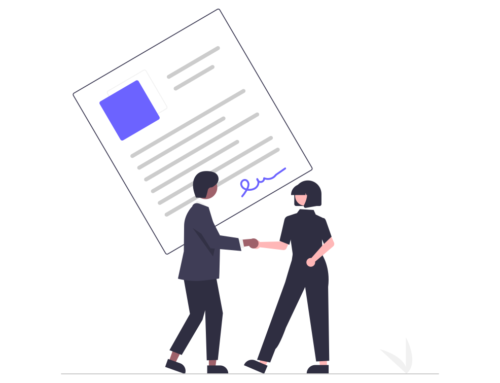Time is precious, everybody knows it, but rarely does anyone care about it. When you are prospecting, you have to create messages and communications that will answer all the basic questions of your customers. When you have hooked somebody, people will instantly ask themselves:
Engaging prospects with your answers to these questions is key to success. All your communication in prospecting should provide answers to those questions. We have only a couple of seconds to convince people to invest time into getting to know you and your solution, so it’s worth putting strong emphasis on that part.
“What do you want from me?”
At the beginning, find an attracting topic to start the conversation that engages people.
When you have hooked your prospects by email, calls, inmails, etc., “what do you want from me?” is the question that always comes to mind.
Simplicity is the answer when you design the prospecting workflow. Your sentences should bring up topics that are super easy to understand. They should be simple, concrete, and a little bit unexpected. It’s good if you can create curiosity just by the topic of your message.
Forget about meaningless words like innovation, high quality, great team, fantastic product, and others like them.
Prospects firstly want to understand what you want from them and check if it’s interesting for them to invest more time into a conversation with you.
We found that a good hook might be a question of results that come from your product or service!
For example, when we reach people, we simply ask them: “Would you like to talk about the Polish market entrance of your company?”
Yes, we do B2B lead generation, but having customers in Poland is an outcome of our work!
The key aspect is to create a message that will perfectly suit your buyer persona. The question above makes it interesting for a lot of CEOs and owners. But it won’t work with specialists or managers; for them, we have to create different communication.
“Why should I speak with you?”
Why I should speak with you is the next common question that prospects ask themselves.
The answer should be strongly connected with added value and market value proposition. Preparing it and highlighting what benefits come from the meeting with you and your solution is super important. You should be able to do it step by step.
There are many tactics that come on the table. For example, you can ask your customer directly, “What would be the value for you of this and this result that comes from this product?”
Or you can ask them, “Many customers have problems with this and this; do you have a similar problem too?”
During the answer to this question, you can speak about added value or about pain points. Daniel Kahneman in his book “Thinking, Fast and Slow” proves the result that pain motivates more than profits, so you can try to go with this way.
Below you can see how we use it in our example prospecting message:
Topic: “Hi, would you like to talk about the Polish market entrance of your company?” <- answer to the first question.
Message: Poland is 20 times bigger than Estonia and has the same or even smaller costs of operating a business. Many companies from Estonia find Poland as a good country for expansion, but it’s hard to do it without local representatives. <- answer to the 2nd question.
We can represent you in Poland and help you find your end customers or business partners. We will also help you overcome the culture and language barriers during market validation. <- answer to the 3rd question.
Can we make a call to talk about your Polish market entrance? <- call to action.
“What can I get from you?”
Again, the main stage comes to the added value and the process that leads your prospects to get it.
To answer this question well, especially by email or phone, you will talk a little bit about results that come from your solution or about education on why your results are important to your prospects.
During the educational part, the main stage comes to your materials, case studies, and website!
People like stories, so you can tell the story of how your product or service brings results in similar companies.
If you are on a call with your prospects, you can directly ask your customers what the implications of these pain points are and how much money he is able to pay for solving it or if he is able to invest 30 minutes to see the solution for his problems.
During that part of answering questions, well-designed brochures can boost the conversion to the meeting. It’s worth putting them in order into the SMART or STAR, so when you describe your solution, make them specific, measurable, achievable, realistic, and timely. When it comes to the story, try to describe the situation, tasks that you had, actions that you’ve done, and results that come as output.
Again, it’s important to create these materials and answers suitable for every buyer persona, so for all of them and to all segments, you should have prepared specific added value and pain points. You should create a different message and prospecting workflow for all the buyer personas.
You can try to segment your buyer persona by business, technical, or financial people. Then assign added value for dedicated buyer personas. For example, for engineers, it’s worth providing some technical description and added value. For business and finance, some operational information and added value that can give the benefits in money or time.
Remember that people like images and graphics that support imagination. It’s always better to use them in your materials. Especially since studies have shown us we like to think that we work with logic, but the truth is that people are very emotional.
You can create the first impression only once.

I am dedicated to facilitating your entry into the Polish market. At Architecture of Sales, my team and I are committed to enhancing your visibility and boosting sales in Poland through the following strategies:
- Market Validation Activities - We conduct comprehensive market research, analysis, SWOT assessments, competitor evaluations, and direct customer interviews to validate your market approach.
- Lead Generation - Utilizing both outbound and inbound methods, including various Sales Development Representative (SDR) prospecting techniques, we generate high-quality leads to drive your sales pipeline.
- Sales and Marketing Support - Acting as your local sales and marketing department, we adeptly represent your brand to customers, providing comprehensive support to strengthen your market position.
- Business Partner Identification - Whether identifying a local partner or developing an effective affiliate program, we assist in establishing valuable collaborations to optimize your market presence.
While our primary focus is on B2B SaaS companies, we are also open to collaborating with hardware-selling enterprises. For instance, we have successfully sold SaaS solutions, including ERP systems, to diverse sectors such as manufacturing, construction, retail, IT, HR, and EHS management.





